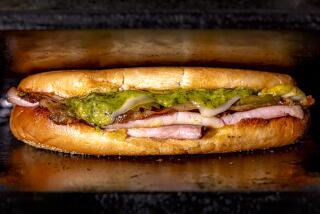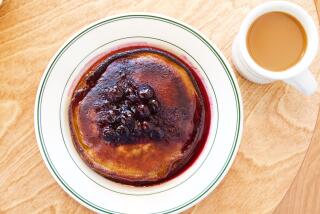[Chef Change] At Cafe Rouge, dinner is the show
I can’t believe it. At 8 o’clock on a Friday night, four of us are the sole guests at Leatherby’s Cafe Rouge, the new restaurant at the Orange County Performing Arts Center in Costa Mesa. Twenty minutes later, two tables are filled. Total. Considering that this is one of the brightest new restaurants to open in Orange County in years, I’m floored. It’s chic and tres moderne, even a little sexy, with a curved glass facade, sleek high-sided booths and a petite bar. South Coast Plaza is only a couple of blocks away, and plenty of other nearby restaurants are packed.
Come at 6 p.m., though, and it’s a different story -- not the early bird special, exactly, but concert-goers dining before a performance at the Renee and Henry Segerstrom Concert Hall. The crowd is dressed up, excited, festive. But as soon as the tasteful chimes ring out, they’re gone, like a flock of wild parrots, to their seats, and this new restaurant from the Patina Group, which owns Pinot Provence around the corner, is left languishing.
I hope not for long. Because the chef, Mark Gold, who most recently ran the kitchen at Cafe Pinot downtown, is turning out some terrific food -- well worth a detour whether or not you’re attending a performance at the arts center. Who knew he could cook like this? The California-French fare he produced at Cafe Pinot was fine for that downtown spot, but what he’s doing at Leatherby’s Cafe Rouge (hereafter referred to as Cafe Rouge) is stronger and more original. Given the opportunity, the 42-year-old chef, a graduate of the the New England Culinary Institute, has turned up the heat from a slow simmer to a rolling boil.
For The RecordLeatherby’s Cafe Rouge: In the review of the Leatherby’s CafeRouge restaurant in the Feb. 7 Food section, Ralph W. Leatherby wasdescribed as the founder of Ralph’s. In fact, the late Leatherby, anarts donor for whom the restaurant is named, was the founder ofUniCare Insurance Co.
At the new cafe, named for arts donor and Ralph’s founder Ralph Leatherby, Gold seems to have been given carte blanche to buy the best ingredients available. And he’s making the most of it. By keeping his menu small, he’s able to be flexible and cook to the moment. For a chef without his own restaurant, it’s got to be a dream job. And he’s rising to the occasion with smart, modern food that’s equally at home in French, Californian and Japanese idioms.
Something special
BEFORE you order, the waiter usually gives a little speech outlining what’s particularly enticing that night. He or she will tell you, almost in passing, what the chef has brought back from the market that day. It could be Atlantic cod, specially selected scallops from Maine, or Kobe tenderloin just in from Japan. He shows you what he’s got, and then he shows you what he can do with it. Who wouldn’t bite?
One day it’s a special giant calamari that Gold has cut into rings the size of bracelets and deep-fried in panko crumbs. The squid is incredibly sweet and tender with an intriguingly delicate taste of the sea, positively aristocratic compared with the usual bland calamari most restaurants serve. And pairing it with a swirl of udon noodles flavored with fresh ginger and a flash of hot pepper is fresh and appealing. He lets the ingredients speak for themselves.
True Kobe beef from Japan is offered another night as a $15 supplement to the tasting menu, or a la carte at $25 per ounce. But unlike at Wolfgang Puck’s steakhouse Cut, where there’s an 8-ounce minimum, here you can order as much or, more importantly, as little as you like. We’re certainly not going for an 8-ounce steak, but one of us splurges on 4 ounces of the fabled beef. It’s tenderloin, and just like its name, butter tender, with a distinct, loose grain and a light, ineffably beefy taste. Though it’s extremely rich, it’s not nearly as heavy as corn-fed prime. Beef of this quality doesn’t need a sauce, nor anything that would cover the flavor of the meat. Gold’s Kobe wears the merest slick of a high-grade Japanese soy sauce, which is much more delicate and nuanced than the typical soy. Garnished with lightly browned slices of garlic, 4 ounces is just about perfect, enough to give each of us a very satisfying bite or two.
There are times when you just want to sit back and let the chef bring it on with a tasting menu. But other times you may feel like having a first course and a main. At Cafe Rouge, you can have the best of both worlds: If there’s something on the tasting menu that catches your fancy, you can usually order it a la carte.
Or if you’re inspired to add a middle course in order to fit in one more dish that sounds delicious -- sea urchin brulee, say -- you can do it. That sea urchin makes a lovely, light first course. It’s bruleed all right, probably with a blowtorch from the look of the tiny black specks, and perched on a square of silky Japanese tofu. For the fun of it, Gold adds two more squares of tofu, one with sesame, the other with yuzu, to create a few subtly delicious bites.
At this point, we’re so focused on our plates, who cares whether there are two other guests or nobody at all?
Just out of the ocean
START off a meal at Cafe Rouge with a dozen chilled oysters on the half shell. I don’t know where Gold gets them, but the bagaduce (from Maine) and kumamoto (from the Northwest) oysters I’ve had here are sublime, served at the ideal temperature -- chilled, but not too chilled to kill the flavor. They’re so pristine and fresh (the server tells us the bagaduce are just 18 hours out of the water) that the chef prefers to serve them without a thing. Though, of course, if you insist on a drop of lemon or some mignonette (shallots and Champagne vinegar), he will oblige.
Sushi grade yellowtail is cut thick, garnished with a dab of yuzu kosho, a paste of yuzu citrus zest, green chile and salt. The fish is exquisite. I order it again on another visit, and this time, the server says they have some beautiful bluefin toro (fatty tuna belly), and I could have both. Cut in domino-sized pieces, the toro is top grade, the same tuna belly you’d be served at the top-tier of sushi restaurants. It bumps the price up from $15 to $40, though. I knew adding toro would mean a higher tariff, but I still think someone should have clarified the price beforehand. Nor did anyone mention that the glass of marvelous sake suggested is $30. It’s a minor quibble. And other than that slip, the service is very professional and, just as rare, comfortable. Waiters are knowledgeable about the food but not pretentious.
One night I look up from my crab salad to see the tall slot of glass in the opposite building, a theater, lighted up and tiny figures with their hands pressed to their ears, using up those cellphone minutes during intermission. They may be seeing a scintillating piece of theater, but right now, I’m not a bit envious, I realize, and take another bite of the chilled lump crabmeat. The taste is pure and direct, without the crutch of a heavy dressing. Just the crab, ma’am, molded into the shape of a square cedar sake cup and sitting on a shallow lake of yuzu gelee, so that you get the occasional bright blast of citrus with the crab.
From our table by the window, we get a bird’s-eye view of the courtyard with a soaring Richard Serra sculpture at the far end. Just as I’m admiring its strength and presence, a strange figure cuts across the square, a bassist with his instrument strapped to his back. Leaning forward, he looks like an improbable beetle scurrying off home.
The baby beet salad a vegetarian friend orders looks like an aerial view of a fantastically colored landscape. The tiny beets -- red, gold, coral -- are cut in quarters and glisten like faceted jewels. Micro-beet greens with ruby red veins mix it up, along with triangles of chalky goat cheese. The chef really has an eye, and that’s unusual.
And when my friend comes to order her main course, the server promises something more than plain grilled vegetables, and the chef delivers with a thoughtful composition of perfectly cooked vegetables that goes beyond the usual token vegetarian main course. She’s happy.
Expressionist touch
PORK belly doesn’t give a cook much to work with in terms of presentation: It’s brown. But Gold finds a solution that would make Franz Kline proud. He cuts the pork belly into big cubes, browns them to a deep gold and then drapes the corners with a loose potato puree he calls “liquefied potatoes.” The abstract expressionist touch? A wide band of green apple mustard painted across the plate. The play of unctuous pork against the creamy potatoes and that jolt of mustard really works.
Filet of Arctic char is also a beautiful dish. The fish is a light coral in color, strewn with sauteed blue oyster mushrooms. But before he plates the dish, the chef paints a wide stripe of emerald pesto across the plate. Eating it you experience a play of textures, from the warm, cooked outside down to the cool, translucent center, so rare it’s almost sashimi. The tastes delight and the colors hum.
Other dishes to consider are the venison in Banyuls caramel sauce that plays vinegar and sweet and something grapey against the deep flavor of the game. Colorado lamb arrives under a flurry of lacy kale that looks almost like seaweed, perfectly dressed in oil and vinegar. Underneath hides a beautifully braised lamb shank and the lamb loin cooked medium rare and sliced thick.
The most surprising dish, though, is billed as cream of rice. It’s just another way of saying risotto, though it’s a very loose, creamy one with the big dose of butter only a French-trained chef would add. Stacked to one side, instead of mixed in with the rice, are plump, barely cooked, shrimp and fat asparagus. It’s unconventional, but effective, since each taste remains separate and pure.
After a meal like this, something light is perfect. It could be one of the gorgeous house-made sorbets, such as guava or blood orange, both notable for not being too sweet. There’s a fine creme brulee too.
Chocolate fanatics will go for an elegant fondant of dark, dark chocolate decorated with shards of chocolate brittle and paired with a chocolate gelato. But my heart went to the Breton apple crisp, a tall slab of apples cooked almost to apple sauce, topped with a buttery sugar crust.
As we leave, we wander out into the courtyard to have a better look at the Serra sculpture. The sheaves of iron overlap in such a way, you can step inside to a sort of tepee-shaped space with amazing acoustics. Every sound is amplified, and so somehow, we find ourselves singing doo-wop for awhile before we head off in the direction the bassist took: home.
Leatherby’s Cafe Rouge
Rating: ***
Location: Orange County Performing Arts Center, 615 Town Center Drive, Costa Mesa; (714) 429-7640; www.patinagroup.com/caferouge
Ambience: Chic, contemporary restaurant in the new Renee and Henry Segerstrom Concert Hall in the Orange County Performing Arts Center. It features high-sided, wrap-around booths, tables along the curved glass facade and an understated bar. It gets the pre-theater crowd and then quiets down until the performance lets out, and people filter in for a glass of Champagne or supper.
Service: Variable, from smart and comfortable to unseasoned, but polite and earnest.
Price: Dinner appetizers, $9 to $15; main courses, $22 to $37; desserts, $8; tasting menu, five-course, $75, six-course, $85; lunch appetizers, $6 to $14; main courses, $16 to $23.
Best dishes: Chilled bagaduce oysters, Dungeness crab salad with yuzu, fried calamari with udon noodles, yellowtail with appropriate garnishes, butter-poached Arctic char with blue oyster mushrooms, cream of rice with shrimp and asparagus, Colorado lamb with mountain potatoes, venison with Banyuls caramel sauce, apple Breton crisp with vanilla ice cream and cinnamon syrup.
Wine list: California intensive with a nice list of half bottles, and 20 or so wines by the glass, including dessert wines; corkage is complimentary.
Best table: One against the curved glass windows.
Details: Open for lunch daily from 11 a.m. to 2 p.m. and for dinner daily from 5 p.m. to 10 p.m. Dinner is also served after scheduled performances. Full bar. Valet parking, $8.
Rating is based on food, service and ambience, with price taken into account in relation to quality. ****: Outstanding on every level. ***: Excellent. **: Very good. *: Good. No star: Poor to satisfactory.
More to Read
Eat your way across L.A.
Get our weekly Tasting Notes newsletter for reviews, news and more.
You may occasionally receive promotional content from the Los Angeles Times.






